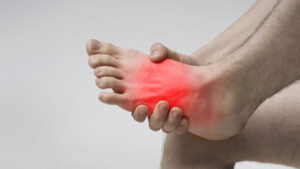Are you troubled by the persistent presence of nail fungus and wondering, “How did I get nail fungus?” Nail fungus, also known as onychomycosis, is a common condition that affects countless individuals worldwide. Understanding the causes and risk factors behind this condition is crucial for effective prevention and treatment. In this article, we will explore the common causes and risk factors associated with nail fungus infections.
What Is Nail Fungus?
Nail fungus is a fungal infection that primarily affects the nails of the toes and fingers. It’s important to note that while this condition may seem minor, it can lead to discomfort and embarrassment if left untreated.
How did I get nail fungus?
Fungal Pathogens
The primary culprits behind nail fungus infections are fungal pathogens. These include dermatophytes, yeasts, and molds. These microscopic organisms thrive in warm and moist environments, making your nails an ideal breeding ground.
Transmission modes of nail fungus
Nail fungus is highly contagious and can spread through various means, including direct and indirect contact. Walking barefoot in public areas like swimming pools, locker rooms, and communal showers increases the risk of exposure.
Vulnerable Areas
Nail fungus tends to target specific areas, with toenails being more commonly affected than fingernails. The warm, dark environment inside shoes provides an ideal setting for fungal growth.
Risk Factors for Nail Fungus
Age-Related Factors
Nail fungus can affect individuals of all ages, but it is more prevalent in certain groups. Elderly individuals and children are particularly susceptible due to differences in immune system function and nail development.
Health Conditions
Several underlying health conditions can increase the likelihood of nail fungus. People with diabetes or weakened immune systems are at greater risk because their bodies struggle to fend off fungal infections.
Lifestyle Factors
Certain lifestyle choices can also contribute to the development of nail fungus. These include wearing tight shoes, having sweaty feet, and experiencing nail trauma. Additionally, visiting nail salons with poor hygiene practices can expose you to the risk of infection.
Environmental Factors
Public spaces, like swimming pools and gym locker rooms, are often breeding grounds for fungal pathogens. The warm, moist conditions in these areas create an environment where nail fungus can thrive.
Recognizing Nail Fungus Infections
Recognizing the symptoms of nail fungus is crucial for early diagnosis and treatment. Look out for signs such as discoloration, thickening, brittle nails, and a foul odor. Diagnosis can be confirmed through visual inspection or laboratory tests.
Nail Fungus Prevention
Prevention is key when it comes to nail fungus. To reduce your risk, practice good hygiene, maintain proper nail care, choose footwear that allows ventilation, and avoid walking barefoot in public places.
Treatment Options
If you’ve already contracted nail fungus, various treatment options are available, ranging from over-the-counter remedies to prescription medications. Laser therapy and home remedies can also be effective in managing the condition.
In conclusion, understanding the causes and risk factors associated with nail fungus is essential for preventing and treating this common condition. By taking proactive steps to maintain healthy nails and being cautious in environments where fungal pathogens thrive, you can significantly reduce the likelihood of asking yourself, “How did I get nail fungus?” Stay vigilant, and prioritize nail health to keep those nails looking and feeling their best.
FAQ’s
Q1: What is the main cause of nail fungus?
A: The primary cause of nail fungus is the presence of fungal pathogens, including dermatophytes, yeasts, and molds. These organisms thrive in warm and moist environments, making nails, especially toenails, susceptible to infection.
Q2: How do fungal nail infections start?
A: Fungal nail infections typically start when fungal spores come into contact with a vulnerable nail. This can happen through direct contact with infected surfaces or indirectly in places like public swimming pools or locker rooms.
Q3: How does nail fungus go away?
A: Nail fungus can be treated and eliminated through various methods, including over-the-counter antifungal treatments, prescription medications, laser therapy, and home remedies. The choice of treatment depends on the severity of the infection.
Q4: Can you ever get rid of nail fungus?
A: Yes, nail fungus can be completely eliminated with the right treatment and care. However, it may take time, and recurrence can happen if preventive measures aren’t followed.
Q5: What kills nail fungus fast?
A: Some prescription medications and laser therapy can provide relatively fast results in treating nail fungus. However, the speed of recovery may vary depending on the individual and the severity of the infection.
Q6: Is it OK to leave nail fungus untreated?
A: Leaving nail fungus untreated is not recommended. If left untreated, the infection can worsen, spread to other nails, and lead to complications. It’s best to seek treatment to prevent further issues.
Q7: Does hydrogen peroxide get rid of toenail fungus?
A: Hydrogen peroxide is not a recommended treatment for toenail fungus. While it has antiseptic properties, it may not effectively eliminate the fungal infection. It’s advisable to consult a healthcare professional for proper treatment options.
Q8: Is nail fungus contagious?
A: Yes, nail fungus is contagious. It can be spread through direct and indirect contact. Avoid sharing personal items like nail clippers or walking barefoot in public areas if you have a fungal nail infection.
Q9: Should I get my nails done if I have a fungus?
A: It is not advisable to get your nails done, especially in a salon, if you have a fungal nail infection. Sharing nail tools and the close proximity of others in the salon can increase the risk of spreading the infection. Focus on treating the infection before considering nail treatments.
Source
- Source: Mayo Clinic – Nail fungus
- Source: CDC – Fungal Nail Infections
- Source: American Academy of Dermatology – Nail Fungus
- Source: WebMD – Nail Fungus
















